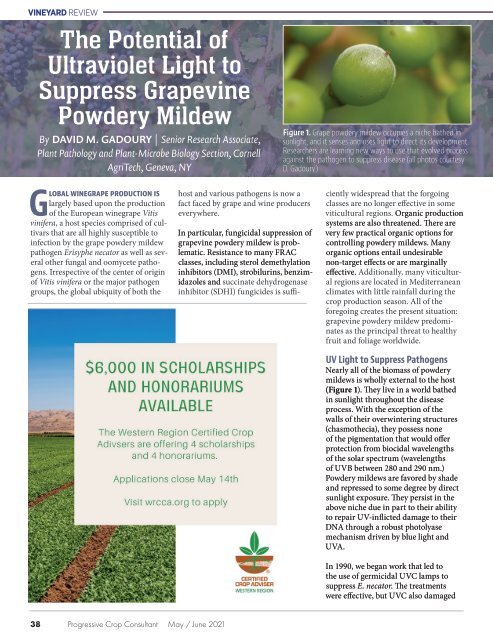Progressive Crop Consultant May/June 2021
You also want an ePaper? Increase the reach of your titles
YUMPU automatically turns print PDFs into web optimized ePapers that Google loves.
VINEYARD REVIEW<br />
The Potential of<br />
Ultraviolet Light to<br />
Suppress Grapevine<br />
Powdery Mildew<br />
By DAVID M. GADOURY | Senior Research Associate,<br />
Plant Pathology and Plant-Microbe Biology Section, Cornell<br />
AgriTech, Geneva, NY<br />
Figure 1. Grape powdery mildew occupies a niche bathed in<br />
sunlight, and it senses and uses light to direct its development.<br />
Researchers are learning new ways to use that evolved process<br />
against the pathogen to suppress disease (all photos courtesy<br />
D. Gadoury.)<br />
Global winegrape production is<br />
largely based upon the production<br />
of the European winegrape Vitis<br />
vinifera, a host species comprised of cultivars<br />
that are all highly susceptible to<br />
infection by the grape powdery mildew<br />
pathogen Erisyphe necator as well as several<br />
other fungal and oomycete pathogens.<br />
Irrespective of the center of origin<br />
of Vitis vinifera or the major pathogen<br />
groups, the global ubiquity of both the<br />
host and various pathogens is now a<br />
fact faced by grape and wine producers<br />
everywhere.<br />
In particular, fungicidal suppression of<br />
grapevine powdery mildew is problematic.<br />
Resistance to many FRAC<br />
classes, including sterol demethylation<br />
inhibitors (DMI), strobilurins, benzimidazoles<br />
and succinate dehydrogenase<br />
inhibitor (SDHI) fungicides is sufficiently<br />
widespread that the forgoing<br />
classes are no longer effective in some<br />
viticultural regions. Organic production<br />
systems are also threatened. There are<br />
very few practical organic options for<br />
controlling powdery mildews. Many<br />
organic options entail undesirable<br />
non-target effects or are marginally<br />
effective. Additionally, many viticultural<br />
regions are located in Mediterranean<br />
climates with little rainfall during the<br />
crop production season. All of the<br />
foregoing creates the present situation:<br />
grapevine powdery mildew predominates<br />
as the principal threat to healthy<br />
fruit and foliage worldwide.<br />
UV Light to Suppress Pathogens<br />
Nearly all of the biomass of powdery<br />
mildews is wholly external to the host<br />
(Figure 1). They live in a world bathed<br />
in sunlight throughout the disease<br />
process. With the exception of the<br />
walls of their overwintering structures<br />
(chasmothecia), they possess none<br />
of the pigmentation that would offer<br />
protection from biocidal wavelengths<br />
of the solar spectrum (wavelengths<br />
of UVB between 280 and 290 nm.)<br />
Powdery mildews are favored by shade<br />
and repressed to some degree by direct<br />
sunlight exposure. They persist in the<br />
above niche due in part to their ability<br />
to repair UV-inflicted damage to their<br />
DNA through a robust photolyase<br />
mechanism driven by blue light and<br />
UVA.<br />
In 1990, we began work that led to<br />
the use of germicidal UVC lamps to<br />
suppress E. necator. The treatments<br />
were effective, but UVC also damaged<br />
38 <strong>Progressive</strong> <strong>Crop</strong> <strong>Consultant</strong> <strong>May</strong> / <strong>June</strong> <strong>2021</strong>


















